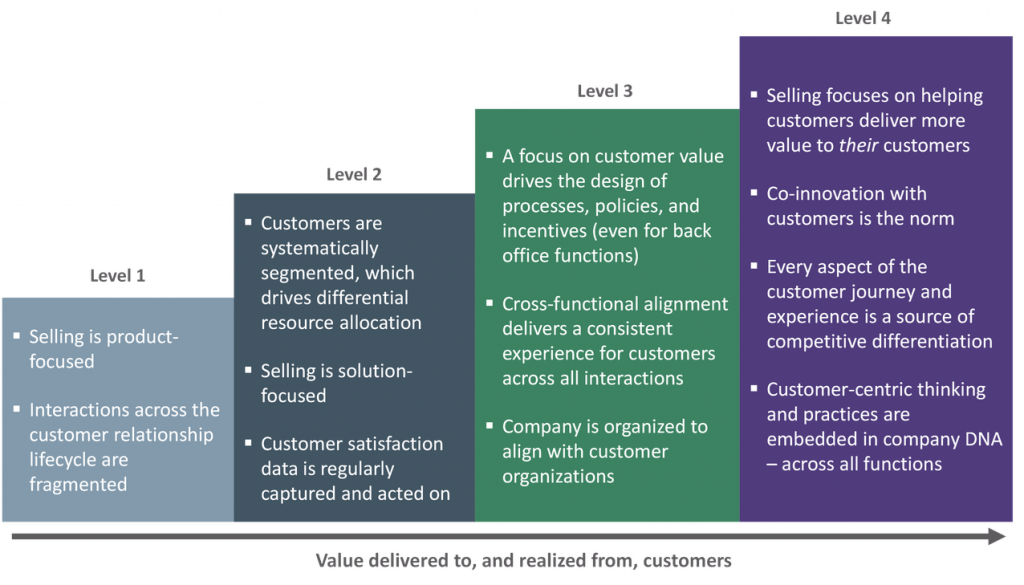Welcome, everyone, to the customer-centric world. Let’s look at successful customer-centricity examples and see how they can benefit your business. Please do not fret; there will be no fancy jargon — just an insights review and step-by-step tutorial. So, grab your drink of choice, get cozy, and let’s begin.
Notice what we just did? You felt reassured and taken care of. This is exactly what customer-centricity is, and we at Fireart know how to do it right.

What’s the buzz about customer centricity?
Gartner says customer-centricity is all about crafting a culture where everyone in an organization knows their customers. We’re talking about their hopes, dreams, fears, and everything in between. Every policy, every philosophy, and every operation in customer-centric companies is designed with the customer in mind.
It’s like throwing a surprise party, where your customer is the show’s star. It’s all about putting them at the center of the universe, not your product.
So, what does it look like in action? Imagine everything you do, from creating digital experiences to real-life services, is tailor-made to provide a fantastic customer experience, consistently adding value. It’s like a five-star restaurant that always serves your favorite dish just as you like it.
What are the customer-centric companies examples?
Who’s rocking the customer-centric boat in the business world? These five examples are at the top of their game:
- Starbucks. They make every coffee run like a cozy chat with your best friend.
- Hilton. They roll out the red carpet for their guests, making every stay memorable.
- Amazon. They practically know your shopping list better than you do.
- Zappos. Customer service is their middle name, and they wear it proudly.
- Netflix. They know what you want to watch before you do. Movie night, anyone?
These examples of customer-centric companies have written the playbook on customer experience. They’re all about loyalty, top-notch customer relationship management, and setting the bar for customers’ expectations.
The nuts and bolts: customer-centric models
Why bother with customer-centricity? It’s like adding sprinkles to your ice cream; it improves everything. One way to do it is by following a customer-centric model. Think of it as the secret recipe for making customer loyalty. Here’s one way it could look:

Some companies come to customer-centricity as they evolve. It’s like building a skyscraper, adding one floor at a time. Each step adds more value, like an elevator that only goes up.
Image source: cmr.Berkeley.edu
Top 10 customer centricity examples for business
Customer-centricity shows us that it isn’t a static concept; it’s a dynamic field that evolves with the customers’ changing needs and expectations. Below are some of the customer-centric approaches, that became fundamental for the top customer-focused businesses.
Hyper-personalization by Amazon
Customers are no longer satisfied with one-size-fits-all marketing. They want experiences tailored precisely to their preferences. Hyper-personalization combines data analytics, AI, and machine learning to create highly individualized customer journeys.
- Example: When you visit Amazon’s website, it shows you product recommendations based on your previous searches and purchase history. If you’ve been shopping for hiking gear, Amazon might suggest related items like hiking boots or outdoor accessories.
Voice of the Customer (VoC) analytics by AirBnB
Gathering and analyzing customer feedback has always been essential, but it’s becoming increasingly sophisticated. VoC analytics leverages advanced tools to collect and interpret customer feedback from various sources, such as surveys, social media, and reviews.
- Example: Airbnb, a global home-sharing platform, uses VoC analytics to collect and analyze host and guest feedback. They use this feedback to improve the quality of listings, enhance customer experiences, and address pain points or concerns, leading to better accommodations and happier travelers.
Augmented Reality (AR) and Virtual Reality (VR) by IKEA
AR and VR technologies are transforming how customers interact with products and services. Retailers, for example, are using AR to provide customers with immersive shopping experiences, allowing them to try on clothing or visualize items in their homes virtually. This trend enhances customer engagement and decision-making.
- Example: IKEA, the Swedish furniture retailer, offers an AR app that allows you to place furniture in the living spaces virtually. This helps customers visualize how IKEA’s products will fit in their homes before purchasing.
Self-service and AI chatbots by Delta Airlines
Customers are increasingly looking for quick and efficient self-service options. AI-driven chatbots are becoming more sophisticated in providing instant responses to customer inquiries. They can handle routine tasks, freeing human agents to focus on complex issues. This successful trend not only improves customer satisfaction but also reduces service costs.
- Example: Delta Airlines employs AI chatbots on its web portal and mobile app, allowing passengers to check flight status, rebook flights, or even track baggage in real-time. These chatbots help passengers efficiently handle routine travel tasks without needing customer service.
Sustainability and social responsibility by Patagonia
Customers are increasingly valuing businesses that demonstrate social and environmental responsibility. Companies embracing sustainability and social causes are creating a stronger emotional connection with their customer base. Customers prefer brands that align with their values, and this trend is driving customer loyalty.
- Example: Patagonia, a renowned outdoor clothing company, is committed to sustainability. They use recycled materials and encourage customers to repair and reuse their clothing. Patagonia’s dedication to environmental responsibility resonates with customers who value eco-friendly practices.
Data privacy and transparency by Apple
Customers are becoming more concerned about data privacy and how their information is used. Companies that prioritize data security and transparency build trust with their customers. Compliance with data protection regulations, clear privacy policies, and transparent data collection practices are vital in today’s customer-centric landscape.
- Example: Apple, the tech giant and the most famous among customer-centric companies examples, is well-known for its commitment to data privacy. They provide clear privacy policies and transparent data collection practices, giving users control over how their data is used and building customer trust.
Multichannel and omnichannel experiences by Starbucks
Customers expect seamless experiences across all channels, from websites and mobile apps to brick-and-mortar stores. Omnichannel strategies are evolving to ensure consistency and convenience. This trend requires businesses to create best product page and integrate data and systems to offer a cohesive experience, no matter how and where customers engage.
- Example: Starbucks, the coffeehouse chain, offers a seamless multichannel experience. Customers can order and pay for their favorite coffee through the Starbucks mobile app, earn rewards, and then pick up their order in-store, ensuring a consistent and convenient coffee-buying process.
Emotional intelligence in customer service by Zappos
Beyond problem-solving, customer service representatives are expected to display empathy and emotional intelligence. Companies are training their teams to understand and connect with clients on a deeper, emotional level. This trend fosters stronger customer relationships and builds brand loyalty.
- Example: Zappos, an online apparel store, is renowned for its customer service representatives’ emotional intelligence. They not only assist customers with orders but also engage in friendly conversations, empathize with customer experiences, and go above and beyond to solve issues.
Subscription-based models by Blue Apron
The subscription-based business model has gained immense popularity. Customers love the convenience of regular deliveries, personalized content, and the feeling of belonging to an exclusive club. This trend has expanded beyond streaming services to include everything from food and fashion to software and fitness brands.
- Example: Blue Apron, a meal kit delivery service, operates on a subscription model. Customers receive weekly meal kits with fresh ingredients and recipes tailored to their dietary preferences. Subscribers enjoy the convenience of cooking delicious meals at home and being part of a cooking community.
Predictive analytics by Spotify
Advanced analytics, including predictive modeling and AI, are used to anticipate customer needs and behavior. Companies can proactively offer relevant products and services by analyzing historical data and current trends. This trend helps businesses stay one step ahead and deliver a smoother customer experience.
- Example: Spotify, the music streaming service, is one of the customer-centricity examples. It employs predictive analytics to curate personalized playlists for users. By analyzing listening habits and genre preferences, Spotify’s algorithms create “Discover Weekly” playlists, suggesting new music that aligns with the user’s taste and keeps them engaged with the platform.
Challenges of staying customer-centric
Sustaining a customer-centric approach, though rewarding, comes with its fair share of hurdles:
- Work performance. Exceeding customer expectations requires consistent, high-quality work. Diligent performance fosters repeat business, and customers are often willing to pay more for exceptional service.
- Acknowledging customer problems & needs. Understanding your customers is the key. Regular market research and feedback loops help fine-tune the successful customer experience.
- Corporate culture growth. Creating and nurturing a customer-centric culture is a marathon. In such a culture, employees should strive to deliver quality service at every interaction, forming a customer-centric mindset.
- Building long-term relationships. Customer interactions shouldn’t end with a purchase. Businesses employ loyalty programs, tailored offers, and regular content updates to retain customers and maintain a customer-centric approach.
- Studying customer journey maps. Understanding the process from the customer’s perspective is essential to build a truly customer-centric business. It’s about eliminating pain points and ensuring the company helps customers at different stages of their journey.
- Anticipation of customer desires. Successful companies can predict customer needs and offer the right product or service, creating strong customer loyalty and increasing profits.
How to build a customer-centric company?
Creating a customer-centric company is a multi-step process that involves a holistic approach. Here’s a step-by-step guide to help you transform your business into a customer-centric organization:
Step 1: Ensure leadership commitment
- Customer-centric organization structure starts at the top. Leadership commitment is crucial. The company’s leaders must champion the cause of customer-centricity. They need to understand and embrace the concept of leading by example.
Step 2: Define your customer-centric vision
- Clearly articulate your customer-centric vision. What does being customer-centric mean for your organization? Define your core values, mission, and goals, all centered around delivering exceptional customer experiences.
Step 3: Understand your customers
- Invest in getting your customers right. Create detailed customer personas. Don’t just sit in front of your laptop – go out and speak to real people using your product. Use interviews and surveys to gather and visualize data.
Step 4: Align your teams
- Ensure that your employees share the customer-centric vision. Provide training and support to help them understand their role in delivering superior customer experiences.
Step 5: Map the customer journey
- Map the customer journey. Understand the touchpoints and interactions customers have with your company. Identify areas where you can improve their experience, for example, with animated content.
Step 6: Implement customer-centric policies
- Develop policies and guidelines that prioritize the customer. Ensure that these policies are integrated into your company’s day-to-day operations.
Step 7: Empower employees
- Give your employees authority to make decisions that benefit the customer. You should encourage them to go the extra mile to solve customer problems and create memorable experiences.
Step 8: Collect and use customer feedback
- Continuously collect and analyze customer feedback. Use this information to improve your products, services, and processes.
Step 9: Innovate for the customer
- Foster a culture of innovation focused on improving the customer experience. Encourage employees to solve customer issues on the spot and go the extra mile.
Step 10: Measure and monitor
- Establish Key Performance Indicators (KPIs) to measure customer-centric success. Monitor these KPIs regularly to assess your progress and make necessary adjustments.
Step 11: Evolve and adapt
- Be ready to evolve and adapt as customer needs and expectations change. Stay ahead of market trends and emerging technologies to remain competitive and customer-focused.
Step 12: Use customer-centric technology
- Leverage technology that supports your customer-centric strategy. Invest in CRM (Customer Relationship Management) systems, analytics tools, and customer service platforms to better serve your customers.
Becoming a customer-centric company is an ongoing journey requiring commitment and a genuine desire to prioritize the customer in all aspects of your business. Remember, it’s not just about satisfying your customers; it’s about creating loyal advocates who will champion your brand.
In the end, it’s all about the successful customer
Customer-centricity isn’t a buzzword; it’s a way of life. Brands are turning on the charm at a party, making every guest feel like a VIP. If you’re in the business of selling products or services, customer-centricity is the golden ticket. It’s about improving customer relationships, boosting loyalty, and delivering a top-notch experience.
So, why not embrace the world of customer-centricity and serve up your products and services with excellence?
If you need a little help or some digitalization magic to improve customer experience, don’t hesitate to check our cases and contact us today. We’re here to sprinkle a bit of customer-centric fairy dust on your business. Let’s become customer-focused and make your clients feel like royalty!






















